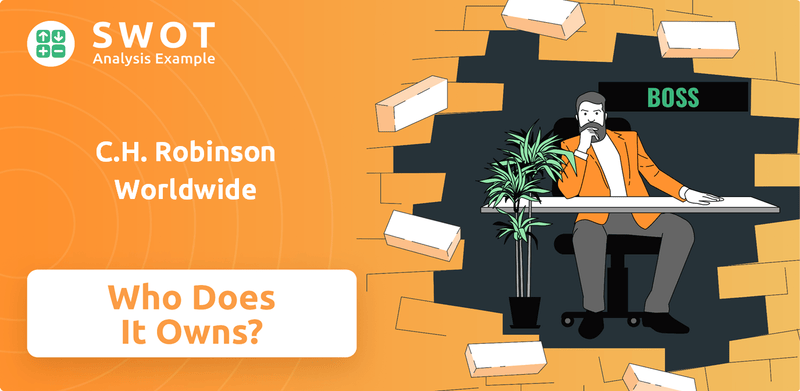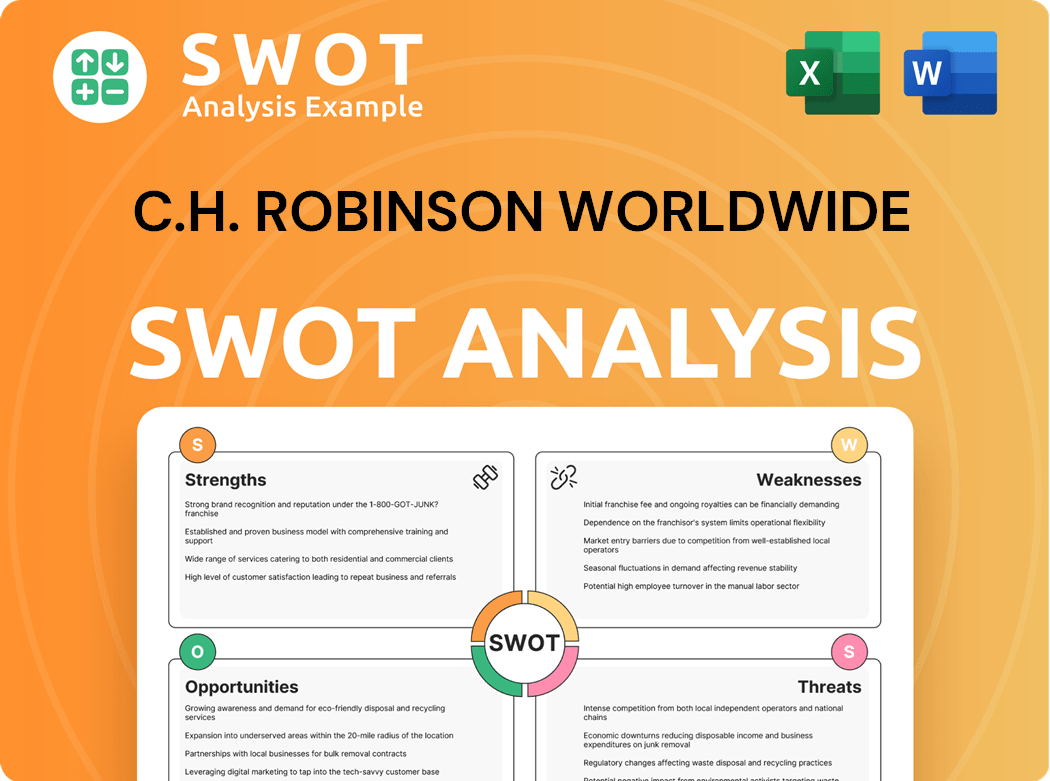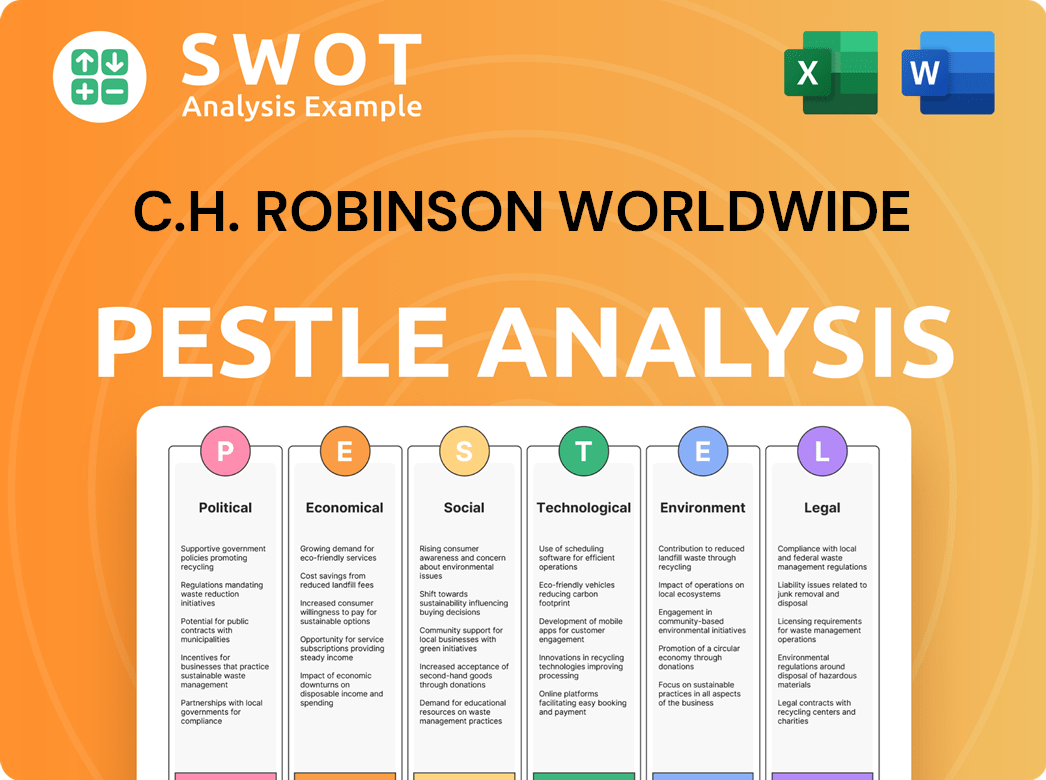C.H. Robinson Worldwide Bundle
Who Really Controls C.H. Robinson?
Understanding the ownership of a company is crucial for investors and stakeholders alike. C.H. Robinson Worldwide, a logistics giant managing billions in freight, has a fascinating ownership journey. From its humble beginnings in 1905 to its current status as a global leader, the evolution of its ownership structure has significantly shaped its path. This article explores the key players behind C.H. Robinson Worldwide SWOT Analysis and their impact on the company's strategies.

Delving into the C.H. Robinson ownership reveals a complex interplay of founders, institutional investors, and public shareholders. Knowing who owns C.H. Robinson provides insights into its strategic decisions and long-term goals. Examining the C.H. Robinson owner and C.H. Robinson company structure helps to understand its market position, governance, and future prospects, including its C.H. Robinson stock performance and the influence of major shareholders.
Who Founded C.H. Robinson Worldwide?
The story of C.H. Robinson starts with Charles Henry Robinson, who launched a wholesale brokerage in Grand Forks, North Dakota, in the early 1900s. This marked the beginning of what would become a major player in the logistics industry. Understanding the evolution of C.H. Robinson ownership provides crucial insights into the company's journey.
On April 11, 1905, Charles Henry Robinson joined forces with the Nash brothers, owners of Nash Finch Company. This partnership led to the formal incorporation of the C.H. Robinson Company, with Robinson as its first president. The initial financial details, including capital and equity splits, are not widely available, but the business was built on Robinson's resources and reinvested earnings.
The early years set the stage for the company's future, with shifts in C.H. Robinson owner dynamics shaping its direction. This history is essential for anyone looking to understand the current C.H. Robinson company.
Charles Henry Robinson founded the company, serving as its first president. The Nash brothers of Nash Finch Company were early partners.
The initial capital came from Charles Henry Robinson and reinvested earnings. The Nash brothers held a significant stake through Nash Finch Company.
After Charles Henry Robinson's passing in 1909, the Nash brothers took control. Nash Finch Company eventually gained sole ownership.
In the early 1940s, the company split into two entities due to Federal Trade Commission findings. This led to a structure where employees held ownership in one part.
The two entities merged in the mid-1960s, with Nash Finch holding about a 25% stake. By 1976, C.H. Robinson became fully employee-owned.
The employee-owned structure lasted until the company's Initial Public Offering (IPO). This marked a significant shift in the C.H. Robinson ownership landscape.
The transformation from its founding to its current status as a publicly traded company reveals a dynamic history. The journey from its origins with Charles Henry Robinson to its eventual IPO provides a comprehensive view of the company's evolution. For more details on the company's business model and revenue streams, you can read more in the article about Revenue Streams & Business Model of C.H. Robinson Worldwide.
The early ownership structure of C.H. Robinson was initially centered around Charles Henry Robinson and the Nash brothers. The company transitioned through various ownership models, including Nash Finch's control and employee ownership, before becoming a public company.
- Founded by Charles Henry Robinson in the early 1900s.
- Partnership with Nash Finch Company led to incorporation in 1905.
- Nash Finch gained sole ownership by 1913.
- Split into two entities in the 1940s, one employee-owned.
- Consolidated in the mid-1960s, with Nash Finch holding a 25% stake.
- Became 100% employee-owned by 1976.
- Transitioned to a public company through an IPO.
C.H. Robinson Worldwide SWOT Analysis
- Complete SWOT Breakdown
- Fully Customizable
- Editable in Excel & Word
- Professional Formatting
- Investor-Ready Format

How Has C.H. Robinson Worldwide’s Ownership Changed Over Time?
A pivotal moment in the history of C.H. Robinson's ownership occurred in 1997. The company, then known as C.H. Robinson, changed its name to C.H. Robinson Worldwide, Inc., and launched its Initial Public Offering (IPO). This IPO generated $190 million for the 101 employees who sold their shares. The firm began trading on NASDAQ under the symbol CHRW. Its initial market value was $743 million. The IPO marked a significant shift, transforming the company's ownership structure and opening it up to public investment.
As of June 12, 2025, the share price was $95.00, reflecting a 12.40% increase over the past year. The company's market capitalization is approximately $11.23 billion as of June 11, 2025. This growth demonstrates the company's performance since its IPO and its continued presence in the market. The shift to public ownership allowed for greater capital access and increased visibility within the financial markets, shaping its trajectory in the logistics industry.
| Ownership Category | Percentage | Details |
|---|---|---|
| Institutional Shareholders | 94.20% | Major ownership by large investment firms. |
| Insiders | 13.95% | Shares held by company insiders. |
| Retail Investors | 0.00% | Minimal retail investor ownership. |
Currently, C.H. Robinson Worldwide (NASDAQ: CHRW) is primarily owned by institutional shareholders, who account for 94.20% of the company's ownership. Insiders hold 13.95% of the shares, while retail investors hold 0.00%. As of March 31, 2025, significant institutional investors include Vanguard Group Inc. (14,586,381 shares, 12.29% ownership), First Eagle Investment Management, LLC (10,732,177 shares, 9.04% ownership), BlackRock, Inc. (10,703,207 shares, 9.01% ownership), and State Street Corp (7,023,591 shares, 5.92% ownership). These figures highlight the concentration of ownership within large investment firms. The institutional ownership remained largely unchanged at 96.10% in May 2025. For a deeper understanding of the competitive environment, consider exploring the Competitors Landscape of C.H. Robinson Worldwide.
The majority of C.H. Robinson is owned by institutional investors.
- The IPO in 1997 was a major turning point.
- Share price and market capitalization reflect the company's value.
- Major shareholders include Vanguard, BlackRock, and State Street.
- The ownership structure indicates strong institutional confidence.
C.H. Robinson Worldwide PESTLE Analysis
- Covers All 6 PESTLE Categories
- No Research Needed – Save Hours of Work
- Built by Experts, Trusted by Consultants
- Instant Download, Ready to Use
- 100% Editable, Fully Customizable

Who Sits on C.H. Robinson Worldwide’s Board?
The Board of Directors at C.H. Robinson Worldwide oversees the company's strategic direction and governance. Jodee Kozlak currently serves as the Chair of the Board. David Bozeman, the Chief Executive Officer, is also a member of the board. The board's composition includes independent directors and representatives of significant stakeholders, ensuring a balance of perspectives in decision-making.
C.H. Robinson's board is committed to ongoing refreshment, ensuring it has the expertise necessary to support the company's non-asset, technology-enabled platform. This includes driving growth through digital innovation. For example, Jim Barber and Henry Maier will not be standing for re-election when their terms end at the 2025 annual meeting, indicating an evolution in board membership.
| Director | Title | |
|---|---|---|
| Jodee Kozlak | Chair of the Board | |
| David Bozeman | Chief Executive Officer and Director | |
C.H. Robinson operates under a one-share-one-vote structure. This is common for publicly traded companies. Each share of common stock generally entitles the holder to one vote on matters submitted to a vote of shareholders. As of February 12, 2025, there were 118,705,622 shares outstanding. The aggregate market value of voting stock held by non-affiliates as of June 28, 2024, was over $10.29 billion. Recent proxy statements, such as the DEF 14A filed on March 25, 2025, detail proposals for shareholder votes, including director elections and advisory votes on executive compensation. Understanding the Target Market of C.H. Robinson Worldwide can provide further context on the company's operations.
The Board of Directors at C.H. Robinson oversees the company's governance. Shareholders vote on key matters, with each share typically carrying one vote. Board members include independent directors and the CEO.
- Jodee Kozlak is the Chair of the Board.
- David Bozeman is the CEO and a board member.
- The company uses a one-share-one-vote structure.
- Recent proxy statements outline shareholder voting proposals.
C.H. Robinson Worldwide Business Model Canvas
- Complete 9-Block Business Model Canvas
- Effortlessly Communicate Your Business Strategy
- Investor-Ready BMC Format
- 100% Editable and Customizable
- Clear and Structured Layout

What Recent Changes Have Shaped C.H. Robinson Worldwide’s Ownership Landscape?
In the past few years, C.H. Robinson has navigated a challenging freight market, particularly the North American freight recession that began in mid-2022 and continued through 2024. Despite these market conditions, the C.H. Robinson company reported increased profitability and revenue in Q4 2024. Gross profits increased by 10.4% to $672.9 million, and income from operations rose by 71.1% to $183.8 million. For the full year 2024, total revenues increased by 0.7% to $17.7 billion, and gross profits rose 5.8% to $2.7 billion.
Regarding C.H. Robinson ownership trends, institutional investors continue to hold the majority of shares. As of May 2025, institutional ownership remained at 96.10%. Insiders slightly decreased their holdings to 0.45% in May 2025. Significant institutional activity in Q4 2024 included Van Eck Associates Corp adding over 3 million shares, while Cresset Asset Management, LLC and Interval Partners, LP reduced their positions. If you are interested in learning more about the company's strategies, you can read about it in Growth Strategy of C.H. Robinson Worldwide.
| Metric | Q4 2024 | Full Year 2024 |
|---|---|---|
| Gross Profit | $672.9 million (up 10.4%) | $2.7 billion (up 5.8%) |
| Income from Operations | $183.8 million (up 71.1%) | |
| Total Revenue | $17.7 billion (up 0.7%) |
C.H. Robinson has consistently returned capital to shareholders through share buybacks and dividends. In Q4 2024, $82.8 million was returned to shareholders, including $74.5 million in cash dividends and $8.3 million in stock repurchases. For the first nine months of 2024, the company returned $282.8 million, with $218.9 million in dividends and $63.9 million in share repurchases. As of March 31, 2025, the company had $47.7 million in share buybacks. Capital expenditures for 2025 are projected to be between $65 million and $75 million.
Institutional investors hold a substantial majority of C.H. Robinson stock. As of May 2025, institutional ownership remained at 96.10%.
Despite market challenges, C.H. Robinson increased profitability in Q4 2024, with gross profits up 10.4% and income from operations up 71.1%.
The company returned $82.8 million to shareholders in Q4 2024, including dividends and share repurchases, demonstrating its commitment to shareholder value.
Capital expenditures for 2025 are expected to be between $65 million and $75 million, indicating ongoing investment in the business.
C.H. Robinson Worldwide Porter's Five Forces Analysis
- Covers All 5 Competitive Forces in Detail
- Structured for Consultants, Students, and Founders
- 100% Editable in Microsoft Word & Excel
- Instant Digital Download – Use Immediately
- Compatible with Mac & PC – Fully Unlocked

Related Blogs
- What are Mission Vision & Core Values of C.H. Robinson Worldwide Company?
- What is Competitive Landscape of C.H. Robinson Worldwide Company?
- What is Growth Strategy and Future Prospects of C.H. Robinson Worldwide Company?
- How Does C.H. Robinson Worldwide Company Work?
- What is Sales and Marketing Strategy of C.H. Robinson Worldwide Company?
- What is Brief History of C.H. Robinson Worldwide Company?
- What is Customer Demographics and Target Market of C.H. Robinson Worldwide Company?
Disclaimer
All information, articles, and product details provided on this website are for general informational and educational purposes only. We do not claim any ownership over, nor do we intend to infringe upon, any trademarks, copyrights, logos, brand names, or other intellectual property mentioned or depicted on this site. Such intellectual property remains the property of its respective owners, and any references here are made solely for identification or informational purposes, without implying any affiliation, endorsement, or partnership.
We make no representations or warranties, express or implied, regarding the accuracy, completeness, or suitability of any content or products presented. Nothing on this website should be construed as legal, tax, investment, financial, medical, or other professional advice. In addition, no part of this site—including articles or product references—constitutes a solicitation, recommendation, endorsement, advertisement, or offer to buy or sell any securities, franchises, or other financial instruments, particularly in jurisdictions where such activity would be unlawful.
All content is of a general nature and may not address the specific circumstances of any individual or entity. It is not a substitute for professional advice or services. Any actions you take based on the information provided here are strictly at your own risk. You accept full responsibility for any decisions or outcomes arising from your use of this website and agree to release us from any liability in connection with your use of, or reliance upon, the content or products found herein.